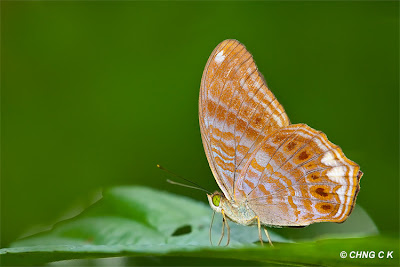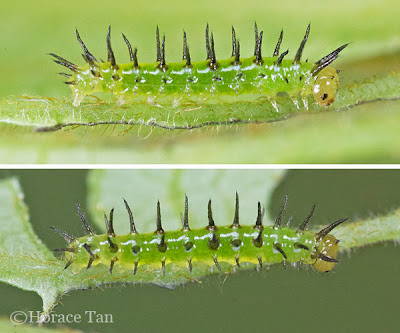Butterfly Biodata:
Genus: Terinos Boisduval, 1836
Species: terpander Hewitson, 1862
Subspecies: robertsia Butler, 1867
Wingspan of Adult Butterfly: 60-70mm
Caterpillar Local Host Plant : Rinorea anguifera (Violaceae).
Physical Description of Adult Butterfly:
The wings are angled with the hindwing slightly toothed at the end of vein 4. Above, the wings are rich purplish blue with two white spots in spaces 3 and 4 on the hindwing. Underneath, the wings are purple-brown with reddish brown and pale blue (shiny in fresh specimens) fasciae crossing both wings. The hindwing has a white submarginal band which is broader and more lunulate in spaces 2 to 4, and a series of dark purple brown post-discal spots which are ringed in orange.
Field Observations of Butterfly Behaviour:
The Royal Assyrian is moderately rare in Singapore. The species is usually encountered in parts of the nature reserves where its host plant, Rinorea anguifera, is growing. The adults have been observed to visit flowers for nectar. When resting, the adults typically perch on the underside of a leaf with its wings closed. The males have also been observed to puddle on damp patches.
Early Stages:
The sole local host plant recorded, Rinorea anguifera, is found at several sites within the Central Catchment Reserves. The caterpillars of the Royal Assyrian feed on young and immature leaves of the host plant.
Local host plant: Rinorea anguifera.
The fruits of Rinorea anguifera.
The eggs of the Royal Assyrian are laid singly on a leaf of the host plant, typically on its under surface. Each creamy white egg is somewhat globular with its surface covered with rectangular pits sandwitched between longitudinal ridges. It has a cross-sectional diameter of about 0.7-0.8mm.
An egg of the Royal Assyrian laid on the underside of a leaf.
Two views of an egg of the Royal Assyrian.
Each egg takes about 3 days to hatch. The young caterpillar nibbles away a portion of the egg shell to emerge.
It then proceeds to nibble away the rest of the egg shell for its first meal.
Two views of a maturing egg of the Royal Assyrian. The head and body setae can be vaguely seen through the egg shell.
The newly hatched is creamy white with a a body length of about 2mm, and a head capsule which is pale beige brown. The body surface has dorso-lateral and lateral rows of short dark setae.
Two views of a newly hatched caterpillar, length: 2mm.
Two views of a 1st instar caterpillar, length: 3.6mm.
As the 1st
instar caterpillar grows up to a length of about 4 to 4.5mm, the body turns yellowish with a strong green undertone. After about 2 days in the 1st instar, the caterpillar
moults to the next instar.
A late 1st instar caterpillar, dormant prior to its moult, length: 4.2mm.
The 2nd instar caterpillar has a yellowish body with a green undertone. The head capsule is pale yellow with two tiny black cephalic horns. The numerous fine setae in the 1st instar are replaced by dorso-lateral and lateral rows of moderately long and pointed black spines. This instar lasts about 2 days with the body length reaching up to 6.5mm before the next moult.
A newly moulted 2nd instar caterpillar, length: 3mm.
Two views of a 2nd instar caterpillar, length: 5.8mm.
Two views of a late 2nd instar caterpillar, dormant prior to its moult, length: 6mm.
The 3rd instar caterpillar resembles the 2nd instar caterpillar closely. The main change occurs in the head capsule where the two cephalic horns are more pointed and longer. A black patch can be seen at the foot of each horn. Further black patches can be found on both sides of the adfrontal area, and where the stemmata (eyes) are. All the pointed spines are proportionately longer. The 3rd instar takes about 2-3 days to complete with the body length reaching up to 10-11mm.
Two views of a 3rd instar caterpillar, early in this stage, length: 6.3mm.
Two views of a 3rd instar caterpillar, length: 11mm.
Two views of a late 3rd instar caterpillar, dormant prior to its moult, length: 10mm.
In the 4th instar, the caterpillar again has proportionally longer cephalic horns and body spines. There are discontinuous dark brown dorsal patches adorning the yellowish green body. Faint white to pale yellowish bands, occuring dorso-laterally and laterally, become increasingly discernible as growth progresses in this instar. This penultimate instar lasts about 3-5 days with body length reaching about 22-24mm.
Two views of a 4th instar caterpillar, early in this stage, length: 12mm.
Two views of a 4th instar caterpillar, length: 17mm.
Two views of a late L4 caterpillar, dormant prior to its moult, length: 23mm.
The next moult brings the caterpillar to its 5th and final instar. Again the body spines are proportionately longer. Now the white and pale yellowish bands, occuring dorso-laterally and laterally, are broad and prominent. Also prominent at this stage is a bold whitish band passing through the spiracles on both sides of the body.
The head of a 4th instar caterpillar (left) and a 5th instar caterpillar (right).
Two views of an early 5th instar caterpillar, length: 21mm.
Two views of a 5th instar caterpillar, length: 34mm.
Two views of a 5th instar caterpillar, late in this stage, length: 40mm.
The 5th instar lasts for about 6-7 days, and the body length reaches up to 40mm. Towards the end of the 5th instar, the body gradually shortens in length with the body base colour turning to pale yellowish green. Eventually the caterpillar comes to rest on the underside of a leaf, typically on the midrib. Here it stays dormant for a while before spinning a silk pad and anchoring its anal claspers to it. It then becomes an pre-pupatory larva in this upside-down pose.
A pre-pupatory larva of the Royal Assyrian.
Pupation takes place about 0.5-1 day later. The pupa suspends itself with a cremastral attachment to the silk pad on the substrate. The pupa is mainly green with yellow dorso-lateral processes on most body segments which are mostly short, pointed and red-tipped. The exceptions are in the 2nd thoracic segment, 3rd, 5th and 7th abdominal segments where they are much longer (the longest occurring on the 3rd abdominal segment) and angled laterally. Each pupa has a pair of short red-tipped cephalic horns. A silverish dorsal patch is found on the 2nd abdominal segment. Length of pupae: 18-19mm.
Two views of a pupa of the Royal Assyrian.
Two views of a Royal Assyrian caterpillar found in the field.
After 5 days of development, the pupa turns black as the development within the pupal case comes to an end. Purplish blue patches on the forewing are now visible on the wing pad through the pupal skin. The next day the adult butterfly emerges from the pupal case.
Two views of a maturing pupa of the Royal Assyrian.
A newly eclosed Royal Assyrian clinging on to its pupal case.
References:
- [C&P4] The Butterflies of The Malay Peninsula, A.S. Corbet and H.M. Pendlebury, 4th Edition, Malayan Nature Society.
- Butterflies of Thailand, Pisuth Ek-Amnuay, 2nd Edition, 2012
- A Field Guide to the Butterflies of Singapore, Khew S.K., Ink On Paper Communications, 2010.




































No comments:
Post a Comment